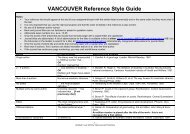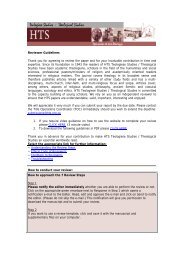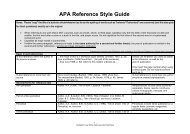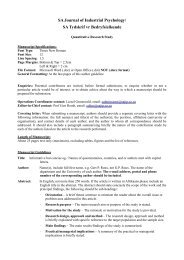SA Journal of Industrial Psychology/
SA Journal of Industrial Psychology/
SA Journal of Industrial Psychology/
Create successful ePaper yourself
Turn your PDF publications into a flip-book with our unique Google optimized e-Paper software.
Key words:<br />
Synopsis:<br />
· Contribution/value-add – A concluding statement indicates the contribution or valueadd<br />
<strong>of</strong> the study in addressing gaps or contradictions in the literature.<br />
Use five [5] words not already included in the title, separated by a semi-colon. Refer to the<br />
discipline; sub-discipline; field; theme; research design; context<br />
Afrikaans articles (or articles in any other <strong>of</strong>ficial <strong>SA</strong> language) must also have a synopsis <strong>of</strong><br />
the article <strong>of</strong> between 500-600 words in English (the entire synopsis appears in italics).<br />
We also ask that you upload a brief biographical note (entered into the ‘Bio statement’ box during the<br />
submission process). This note will appear online in our ‘About the Author’ section should your article be<br />
published with us.<br />
Manuscript Contents<br />
The manuscript contains eight sections, namely the introduction (context <strong>of</strong> the study), research objectives,<br />
motivation <strong>of</strong> the study, research design, results, discussion and the references. All these first-level headings<br />
appear in bold capital letters and are centered.<br />
INTRODUCTION (first-level heading)<br />
The author(s) provide a provocative and thought-provoking introduction to the theoretical discourse/debate<br />
that will attract the attention <strong>of</strong> potential readers. In this section the author(s) provide the context or<br />
background to the discourse or argument by high-lighting or emphasizing specific aspects relevant or<br />
contributing to the discourse or debate. The context or setting <strong>of</strong> the problem provides the décor against<br />
which the problem unfolds. Wherever possible, relevant literature should be cited to provide support for your<br />
arguments. (Refer to the quantitative or qualitative guidelines on writing the introduction section).<br />
Purpose <strong>of</strong> the study (second-level heading)<br />
Against the background or context (explained earlier), in which this debate/discourse unfolds, the purpose <strong>of</strong><br />
the study should be stated clearly and convincingly (but briefly) in this section <strong>of</strong> the manuscript.<br />
Current theoretical perspectives (second-level heading)<br />
A complete and a high-level, critical review <strong>of</strong> the current literature should be provided that illustrates the<br />
different theoretical perspectives/ controversies/ limitations on the theory/methodology in a clear,<br />
comprehensive and in a balanced (objective) way. The review should reflect a high quality <strong>of</strong> scientific<br />
argumentation and logic in the identification <strong>of</strong> the limitations/deficiencies in existing theory/methodology.<br />
The arguments around these deficiencies/limitations should be presented in a coherent/systematic manner.<br />
Existing theoretical perspectives on these problem/issues should be fully and clearly presented.<br />
Problem statement and research objectives (including preliminary literature review) (second-level<br />
heading)<br />
When introducing the problem it should convince the reader that the problem is relevant and topical. The<br />
decision to address a particular research problem can either be triggered by some need identified in practice,<br />
some theoretical problem or by some incompatibilities in opposing academic/theoretical viewpoints.<br />
Theoretical or practical evidence should be provided to verify the existence <strong>of</strong> the problem. The evidence<br />
should be focused and specific, yet sufficiently extensive on a theoretical level to warrant further research.<br />
Care should be taken not to create straw dolls (pseudo-problems) that might come apart at a later stage. The<br />
researchability <strong>of</strong> the problem from a practical and ethical point <strong>of</strong> view should be considered.<br />
A high-level, preliminary literature review should substantiate the existence <strong>of</strong> the problem. It should also<br />
indicate the extent <strong>of</strong> one’s knowledge on each <strong>of</strong> the sub-problems or sub-goals <strong>of</strong> the study. A clear void in




![Reference Style Guide [17-09-2008 Tdv].pdf](https://img.yumpu.com/42195443/1/184x260/reference-style-guide-17-09-2008-tdvpdf.jpg?quality=85)



